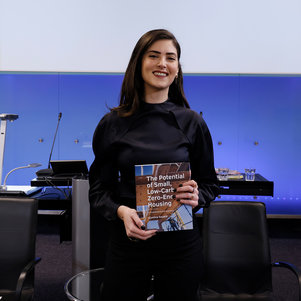Can small, sustainable dwellings help solve the climate crisis and housing shortage? Cynthia Souaid explored whether this solution indeed kills two birds with one stone in her thesis The Potential of Small, Low-Carbon, Zero-Energy Housing. A Multidimensional Approach. "The technology is there, but the human factor is crucial for success," she notes.
In the battle against climate change, construction potentially plays a significant role. The built environment accounts for nearly 40% of global greenhouse gas emissions, and 75% of Europe's building stock consists of residences. Small, energy-efficient houses can thus play a vital role in achieving climate goals. Souaid explains, "Demographic trends in the Netherlands and surrounding countries show that households are shrinking. Simultaneously, there is a significant housing shortage. That's why I investigated whether small, sustainable homes, typically ranging from 40-80 square meters, could offer a sustainable solution."
Less is more
Souaid examined housing projects in the Netherlands (Almere), Ireland (Wexford, Kilkenny and Carlow) and Belgium (Huldenberg, Bertem and Zoutleeuw). The sustainability of these homes partially lies in their usage. "The houses are (almost) energy-neutral; for example, they generate their own energy for heating," Souaid states. However, the most significant climate gains lie in production and the entire supply chain: "These are homes made of wood or recycled concrete. But primarily, the fact that the homes are smaller makes them more sustainable because they require fewer resources. Downsizing homes is a crucial way to reduce production needs and thus emit fewer greenhouse gases."
It might seem like a no-brainer that we should build more of these sustainable homes. Still, Cynthia Souaid wanted to investigate whether they also have the potential to be successful on a large scale. "A lot of research has been done on the technical aspects. We know that wood is a sustainable choice, and we know how to make a home energy efficient. But the human factor is often overlooked: what is the role of professionals in the construction and government sectors? And what about the end user who will live in the homes? This human factor can make or break success."
Business as usual
For her research, Souaid zoomed out and examined the institutional context. She spoke with professionals such as policymakers and developers in the construction sector. "I wanted to discover the barriers or drivers for sustainable housing construction. There is a lot of ambition in the EU to make the housing stock more sustainable, but many of those plans are very voluntary. As long as there is no binding legislation mandating sustainability, too little will happen." Moreover, Souaid observes that the construction industry itself is slow to change. "Professionals in the construction and design realm are often perceived as authorities. However, they frequently revert to business as usual because it is human nature to cling to what we already know. Hence, a cultural shift is necessary, empowering professionals to proactively drive change rather than waiting for political directives. Mediators can play a pivotal role in this endeavour, bridging the gap between policymaking and the practical aspects of the housing market to accelerate change.”
A cultural shift is necessary, empowering professionals to proactively drive change rather than waiting for political directives.
Cynthia Souaid
Small homes can potentially free up a lot of living space in an overcrowded housing market. However, Souaid discovered that there is not always demand for them. "Small homes may be interesting for starters, but empty nesters, couples whose children have moved out, may be able to downsize but often do not want to. They are used to space and comfort and are reluctant to give it up. That's why it's essential to thoroughly investigate for whom exactly projects are being built."
Challenges and opportunities
Souaid's research is complex and does not provide a simple answer to whether small sustainable homes are the holy grail. However, it is clear that much more needs to be done to successfully scale up these housing projects: "You can't just design a super energy-efficient house without talking to experts, clients, and end-users. Only then will you find out where the challenges and opportunities lie. And to realize these ambitious plans, a cultural shift is needed on both the demand side (end-users) and the supply side (contractors, designers, architects, engineers, developers)." Finally, Souaid hopes that further research will focus on reducing rather than increasing. "We need to prioritize avoiding the demand for energy and materials in the first place. We can make much better use of what we already have."
Published: March 2024
- On 7 February 2024 Cynthia Souaid defended her PhD thesis ‘The Potential of Small, Low-Carbon, Zero-Energy Housing. A Multidimensional Approach.’
- You can find the thesis though the DOI link.
Portrait photo made by: RoyBorghouts Fotografie


